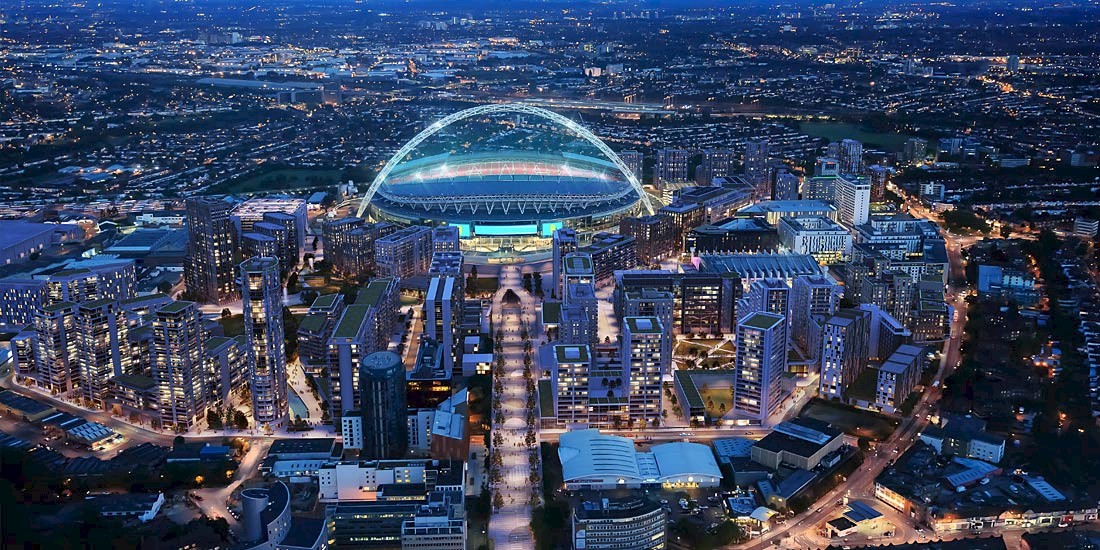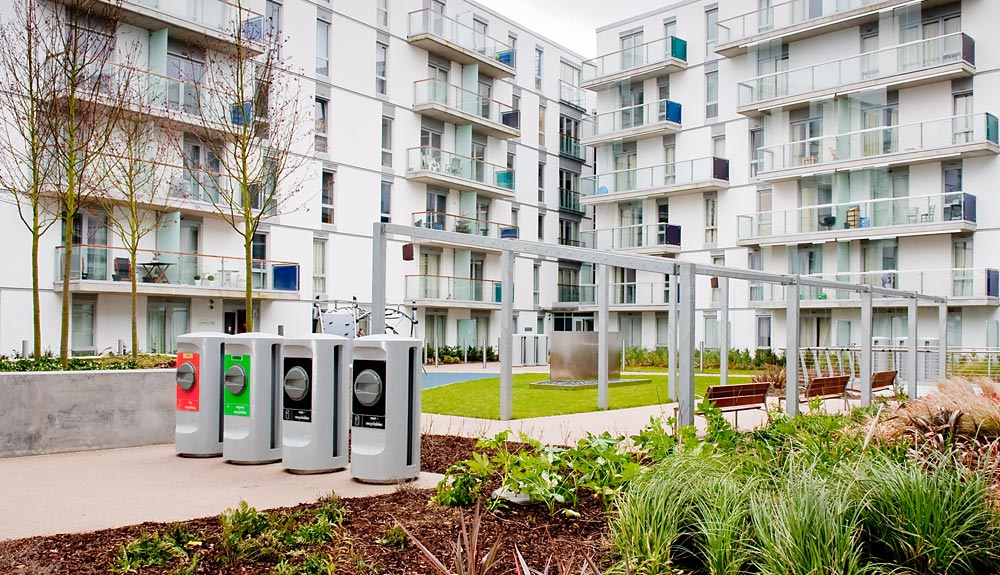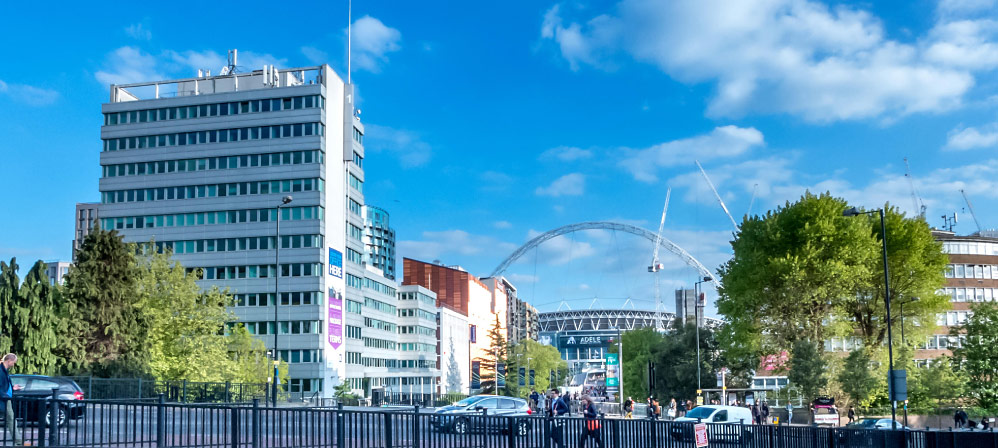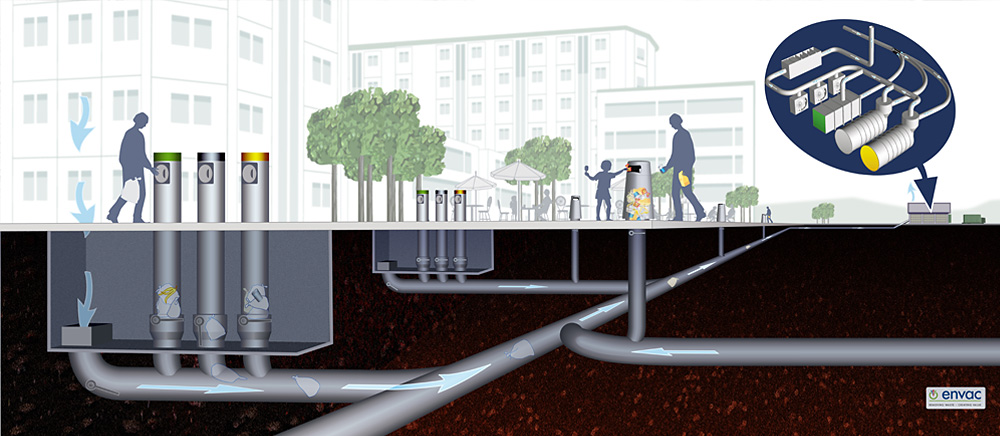Waste Disposal Wembley Park
No traffic jam, no noise, no stench. Down the pipe.
Within a few years, the once rundown Wembley area has become one of London‘s most attractive hotspots. This was made possible by a far-sighted master plan for district development, which also includes an innovative disposal concept that does not require garbage bins: the waste is simply vacuumed off - through pipes from Mannesmann Line Pipe.
The bid for the 2012 London Summer Olympics in 2005 was the initial spark for the revival of the once attractive and rich Wembley district in the northwestern London borough of Brent. However, the commitment to host the games around the new Wembley Stadium was based on three core promises: to create an Olympic Park as a new center for a socially disadvantaged region, to involve citizens and all stakeholders equally in the planning processes from the outset, and to leave behind sports facilities that meet the highest international standards. It is thanks to efficient forward planning and the foresight of the planners for the use after the Olympic Games that the ambitious goals were achieved. In the meantime, a new urban district has been created, the so-called Wembley Park, for which a comprehensive master plan for use after 2012 was developed at an early stage. The project developer Quintain Ltd, which itself is based in London, was and is in charge of the project. By early 2017, Quintain had already invested 900 million pounds in the transformation of the district, according to its own figures. Further planning includes construction measures up to 2026.
New district with mixed use
In a 350,000 m² area around the new Wembley Stadium, which opened in 2007, a completely new district is being built. Besides offering attractive apartments, the district will also take on important local tasks. In addition to a new primary school for 630 pupils, as well as 200 kindergarten places, further public facilities are planned, similar to the Brent Civic Centre which opened in 2012. State-of-the-art office units, retail space, cafés and restaurants as well as numerous sports, event and cultural facilities will provide around 8,500 new permanent jobs. The new district also benefits from the internationally renowned Wembley Stadium. Around 11.5 million visitors came in 2016, and the new London Designer Outlet with over 50 outlet stores recorded over 7 million visitors in 2017.
Every square meter on the test bench
In order to achieve the ambitious goals of almost 30,000 m² of parking space and 170,000 m² of publicly accessible areas in Wembley Park, every square meter was put to the test. Traffic areas and infrastructure facilities were and are therefore planned and built to be as space-saving as possible. For this reason, the objective of the waste disposal concept is to be "sustainable, user-oriented and space-saving". No areas in buildings or in the public space will be wasted on waste containers, no loud clattering of garbage bins will tear the inhabitants from their sleep, and no garbage truck will block the streets or rush-hour traffic. The whole thing was made possible by an invention of the Swedish company Envac: Waste disposal through an extensive underground pipe system.

A smart solution: The chute inlets are color-coded according to the type of waste. No wasted space, no stench, no rattling, no cumbersome transportation. Photos: © Envac
No garbage truck will block the roads and commuter traffic hereGuido Ludwig, Regional Sales Manager
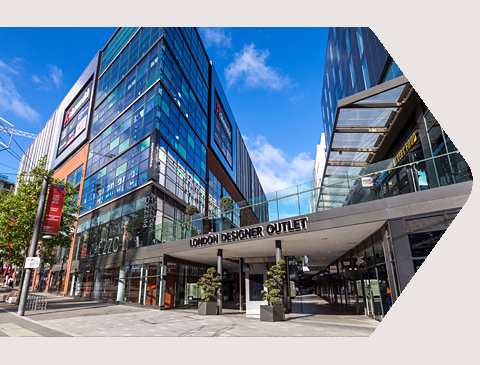
Opened in 2013, the London Designer Outlet houses over 50 stores, 20 restaurants and a cinema. In 2017, it recorded seven million visitors. Photo: © alamy.com
This garbage doesn‘t stink to heaven.
Each of the building units in Wembley Park will receive three containers into which the inhabitants can dump their waste. However, some adaptation is necessary. The waste bags must not be larger than 20 liters. The waste must be separated into organic waste, paper/cardboard and residual waste. A small chip, which is required to open the sluices, registers and allocates the amount of waste to the user. The sacks first fall into an intermediate container below the inlet chute. When a container is full, the waste is vacuumed off into the pipe system. "The pipes used for this purpose have a diameter of 50 cm," explains Nils Schmidt, responsible for the project at Mannesmann Line Pipe. Envac attaches great importance to the tightest manufacturing tolerances so that nothing can get stuck inside the pipe. "Rotors create a vacuum in the pipe system and the refuse sacks are accelerated to around 70 km/h, so they virtually fly through the pipe system," explains Nils Schmidt. In a central collection station, containers are neatly arranged in rows next to each other. "Anyone who thinks it smells like garbage there is wrong," Schmidt says. According to the vacuum cleaner principle, the waste is sucked in and filled directly into closed containers. Thus the whole remains not only a clean but also a low-odor thing.
Smooth operation
Should individual bags of waste be too heavy or too bulky, this won‘t clog up the entire system straight away, because such bags are held back under the inlet chutes. The local waste disposal company receives an error message at the control center and a service employee can rectify the fault on site.
Lasting cooperation
Mannesmann Line Pipe has been supplying HFI-welded steel pipes for the continuously growing pipe system since 2006. Nils Schmidt: "Thanks to our consistent high product quality and short-term scheduling of defined pipe quantities, we have been able to convince Envac as a supplier and as a partner."
The first users have been connected to the system since 2008. A positive side effect of the space-saving and almost traffic-free waste disposal concept is that the local waste disposal company can achieve a recycling rate twice as high as the London average and waste transports can be reduced by approx. 90 %.
Wembley Park
In 2002, the project developer Quintain Ltd purchased the area around Wembley Stadium. The aim is to turn the run-down area into a district worth living in, including local supplies and new permanent jobs.
Nearly 7,000 residential units, over 90,000 m² of state-of-the-art office space, the London Designer Outlet, a new primary school as well as numerous other public buildings and a large park will be available on completion of the restructuring project.
The concept seems to work out very well. In 2016, 11.5 million visitors came to the new Wembley Park district around the new Wembley Stadium, which opened in 2007. In all, approximately 8,500 new permanent jobs are to be created.
Photo: © alamy.com
This is how the "waste vacuum cleaner" works
Waste collection according to the "vacuum cleaner principle" goes back to an idea by Olof H Hallström. As early as the end of the 1950s he developed the vision of simply vacuuming domestic waste away, an idea which the Swedish company Envac brought to market maturity.
The system can be equipped with any number of chutes - depending on how differentiated the waste is to be separated. In Wembley there are three chutes: one for organic waste, one for paper/cardboard and one for residual waste. The inlets are opened manually and the waste bags with a maximum size of 20 liters for households and 120 liters for commercial waste are dropped down the chute, where they fall into an underground container. When a container is full, the control room receives a corresponding message.
Rotors then generate a negative pressure in the pipe system, which vacuums the waste out of the container and transports it in an airflow of 70 km/h to the central collection station and there directly into the correct waste container. Full containers are almost fully automatically exchanged and loaded onto trucks. In addition to central collection without specific space requirements, traffic obstructions and noise emissions, the system also leads to improved waste separation and thus to higher recycling rates. The pipe system with a diameter of approx. 50 cm is installed underground at a depth of about one meter.
